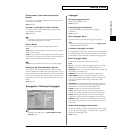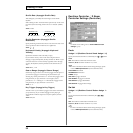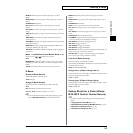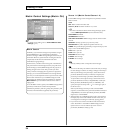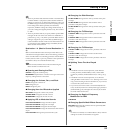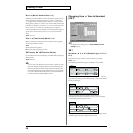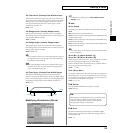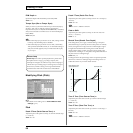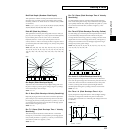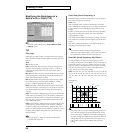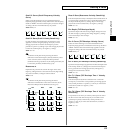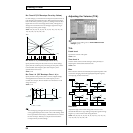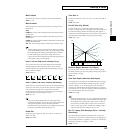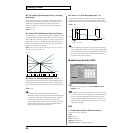
59
Creating a Patch
Creating a Patch
Vel Fade Lower (Velocity Fade Width Lower)
This Determines what will happen to the tone’s level when the tone
is played at a velocity lower than its specified velocity range. Higher
settings produce a more gradual change in volume. If you want
notes played outside the specified key velocity range to not be
sounded at all, set this to “0.”
Value: 0–127
Vel Range Lower (Velocity Range Lower)
This sets the lowest velocity at which the tone will sound. Make
these settings when you want different tones to sound in response to
notes played at different strengths.
Value: 1–UPPER
Vel Range Upper (Velocity Range Upper)
This sets the highest velocity at which the tone will sound. Make
these settings when you want different tones to sound in response to
notes played at different strengths.
Value: LOWER–127
If you attempt to set the Lower velocity limit above the Upper, or
the Upper below the Lower, the other value will automatically
be adjusted to the same setting.
When using the Matrix Control to have different tones played,
set the lowest value (Lower) and highest value (Upper) of the
value of the MIDI message used.
Vel Fade Upper (Velocity Fade Width Upper)
This determines what will happen to the tone’s level when the tone is
played at a velocity greater than its specified velocity range. Higher settings
produce a more gradual change in volume. If you want notes played outside
the specified key velocity range to not be sounded at all, set this to “0.”
Value: 0–127
fig.Vel Range.e
Modifying Waveforms (Wave)
fig.03-15_50
For details on the setting, refer to “How to Make the Patch
Settings” (p. 42).
Wave
Wave Group
Selects the group for the waveform that is to be the basis of the tone.
Value
INT: Waveforms stored in internal memory
XP-A: Waveform stored in a Wave Expansion Board (SR-JV80 series)
installed in EXP-A slots.
XP-B: Waveforms residing on a Wave Expansion Board (SRX series)
installed in the EXP B slot
XP-C: Waveforms residing on a Wave Expansion Board (SRX series)
installed in the EXP C slot
You cannot select a waveform group of a Wave Expansion Board
that is not installed.
Wave No. (L) (Wave Number (L))
Wave No. (R) (Wave Number (R))
Selects the basic waveform for a tone. Along with the Wave number,
the Wave name appears at the lower part of the display.
When in monaural mode, only the left side (L) is specified. When in
stereo, the right side (R) is also specified.
Value: ----, 1–1083
Gain (Wave Gain)
Sets the gain (amplification) of the waveform. The value changes in 6
dB (decibel) steps—an increase of 6 dB doubles the waveform’s gain.
If you intend to use the Booster to distort the waveform’s sound, set
this parameter to its maximum value (p. 57).
Value: -6, 0, +6, +12
FXM Switch
This sets whether FXM will be used (ON) or not (OFF).
Value: OFF, ON
FXM Color
Specifies how FXM will perform frequency modulation. Higher
settings result in a grainier sound, while lower settings result in a
more metallic sound.
Value: 1–4
Range Lower
Range Upper
Fade Lower
Fade Upper
Level
Velocity
FXM
FXM (Frequency Cross Modulation) uses a specified waveform
to apply frequency modulation to the currently selected
waveform, creating complex overtones. This is useful for
creating dramatic sounds or sound effects.



